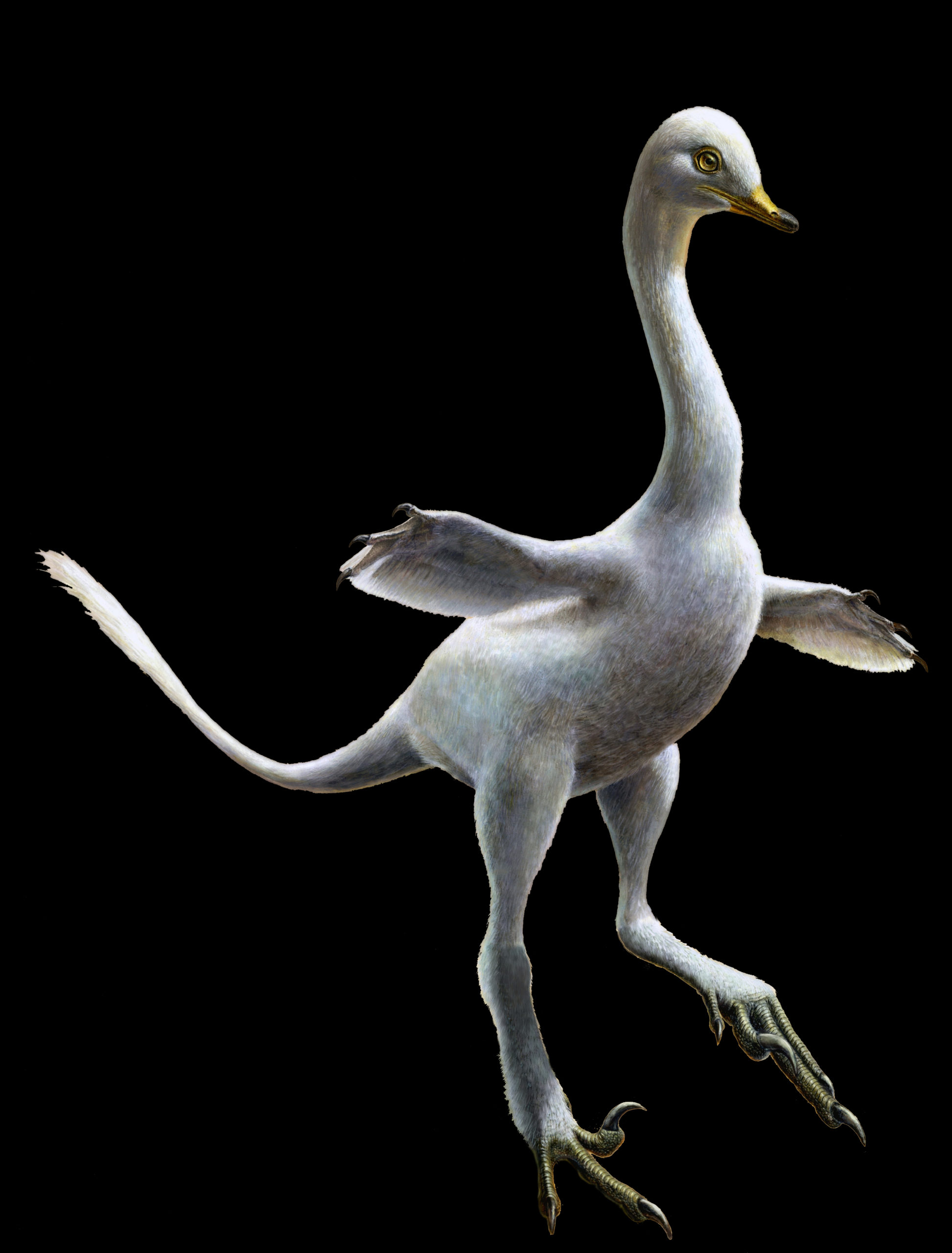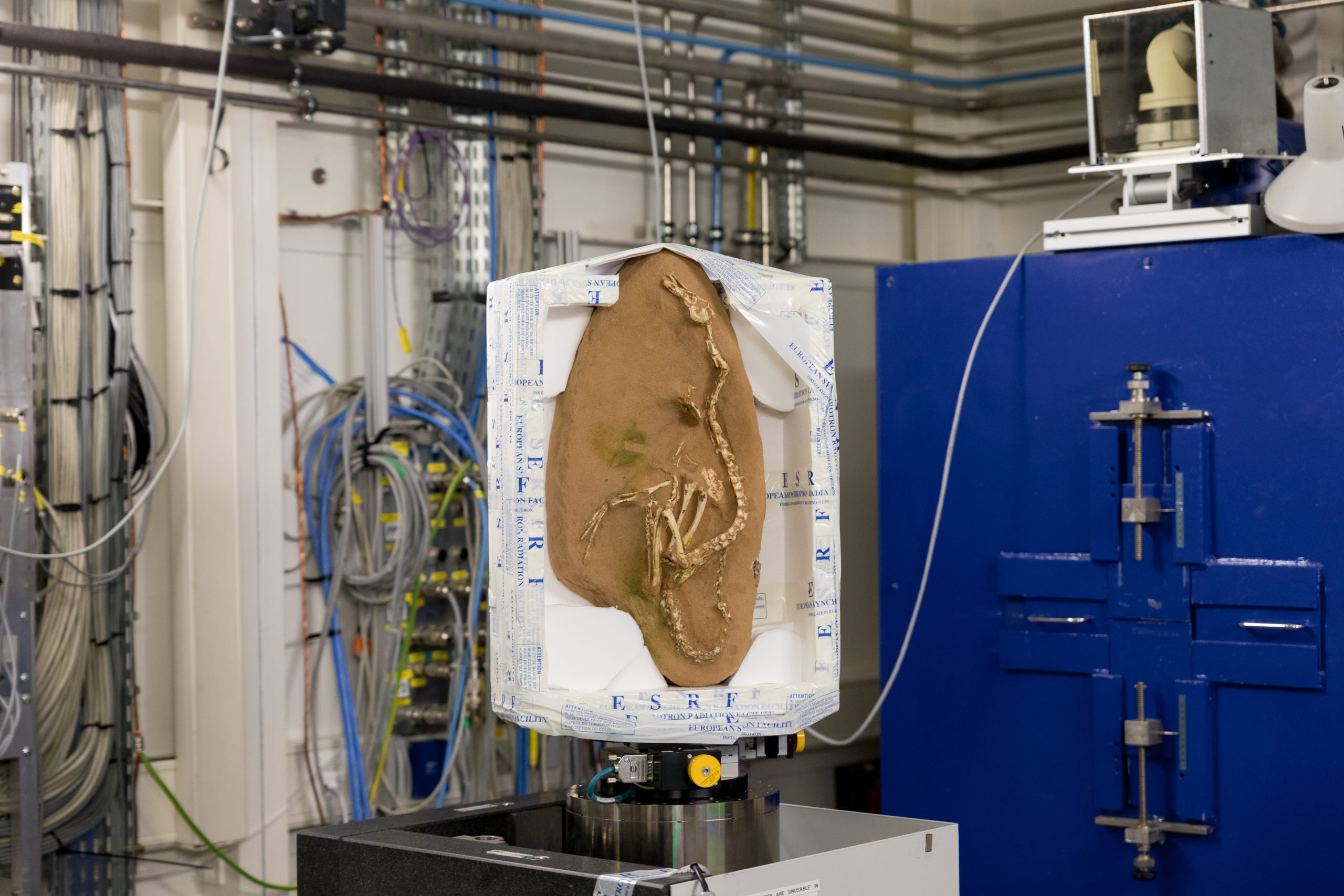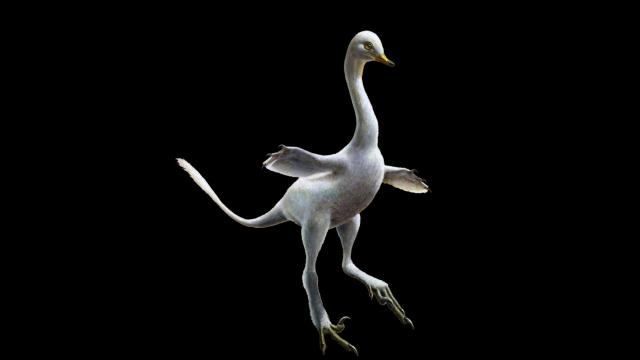The last few years have yielded some truly bizarre dinosaur discoveries. From rhino-like animals with massive heads and stubby spines, to beaked mishmashes of every dinosaur in the book, there’s been a cavalcade of incredible additions. But perhaps none of these quite measures up to the unrelenting strangeness of a newly-discovered species of dinosaur that lived in the Cretaceous period of Mongolia some 75 million years ago.
Reconstruction of Halszkaraptor escuilliei. (Credit: Lukas Panzarin and Andrea Cau)

Reconstruction of Halszkaraptor escuilliei. (Credit: Lukas Panzarin and Andrea Cau)
Behold Halszkaraptor escuilliei, which looked like a duck, walked like a duck, and was amphibious like a duck, but was a member of the infamously predatory and deadly family of fleet-footed raptors. Equipped with clear adaptations for a life spent part-time in the water, Halszkaraptor (prounounced “halls-ka-raptor”) represents the first and only known non-avian theropod dinosaur (a group of bipedal predators that includes T. rex and excludes birds [avians]) to be so at home in the water.
While birds have enjoyed a solid presence between land, air and sea over their evolution, non-avian dinosaurs in general were land-lubbing creatures. As more fossils and information comes to light, our understanding of their diverse ecology has made room for some caveats. But – for example – wholly aquatic non-avian dinosaurs aren’t a thing. It’s also debatable that any non-avian dinosaurs ever took up powered flight – though the four-winged Microraptor might be a contender. This is why Halszkaraptor and its apparent suite of adaptations specifically for swimming and paddling intertwined with a body plan hilariously originating from a lineage known for doing precisely not that is such an revolutionary find.
The exceptionally complete fossil of Halszkaraptor – described in a paper published today in the journal Nature – is originally from Ukhaa Tolgod, Mongolia, but the team of scientists responsible for its description in the scientific literature did not discover it there. The fossil was at some point illegally poached from its productive palaeontological site, and floated between private collections outside of the country for years before being acquired and handed over to palaeontologists in 2015 for study and return to Mongolia.
Because the fossil was fragile, deeply embedded within a rock slab, and one of a kind, the international team of researchers used a high-tech method of visualising and reconstructing Halszkaraptor‘s skeleton in three dimensions. At France’s European Synchotron Radiation Facility, they used a high-powered, highly-sensitive type of X-ray scanning – synchrotron multi-resolution X-ray microtomography – to see and articulate all the internal details of the specimen in the rock without even touching it. This allowed the researchers to confirm that the unusual fossil wasn’t a deceiving amalgamation of multiple dinosaur species, and figure out the animal’s anatomy down to very fine scales.

Picture of Halszkaraptor escuilliei fossil, set up at the ESRF tomography beamline. Credit: ESRF/P. Jayet
What they found was a dromeosaurid – a “running lizard” in the same family as Velociraptor and the much larger Utahraptor – but it was unlike any known raptor. Halszkaraptor was different enough from its flesh-rending cousins that the researchers gave it its own species, genus and a new subfamily (Halszkaraptorinae). The small dinosaur – roughly the size of a mallard duck, appropriately enough – has many of the features found in its fellow raptors: Sickle-claws on the feet; a long, sturdy tail; and a lithe, athletic frame. But Halszkaraptor has a battery of characteristics more akin to modern waterfowl and other aquatic animals than to theropod dinosaurs.
Features of its skull suggest it spent time in the water, pursuing and eating fish. Halszkaraptor had a long, thin snout full of short, prickly teeth perfectly suited for holding onto wriggling fish. Like crocodiles, Halszkaraptor‘s fossil held evidence of a highly-developed mesh of sensory organs in the bones of the snout, suggesting it went after water-based prey. The head was perched on an unusually long, flexible, swan-like neck, which had features in the vertebrae only previously seen in waterfowl and some species of aquatic, long-necked turtles. It’s possible Halszkaraptor snatched up fish like a cormorant or heron – with rapid, ambush strikes of its hypermobile head and neck.
Accessing these fish would have been made easy by the rest of Halszkaraptor‘s swimming-primed body. It’s front limbs were strikingly paddle-like, and analyses of their proportions and the chest region showed closer similarities between Halszkaraptor and wing-propelled birds like penguins than with other theropod dinosaurs, suggesting the dinosaur “flew” through the water by using its arms. Halszkaraptor‘s hips and legs were also oriented more forward, shifting the centre of gravity forward and giving it an independently evolved waterfowl-like posture: Erect and prone to waddling. This configuration could have helped hip extension during swimming.
In life, Halszkaraptor would have looked like a preposterous fusion of a Velociraptor and a goose – which, given the sterling reputation of geese, would probably just make the Velociraptor twice as terrifying, actually. The toddling curiosity would have appeared far removed from any typical raptor, an animal that can be summed up as an ill-tempered knot of feathers and razor wire.
Halszkaraptor is the only non-avian dinosaur to have dual locomotory modes where one way of getting around is paddling with the arms. The massive sail-backed Spinosaurus was revealed recently to be probably semi-aquatic – with its dense bones and eel-like swimming capabilities – though even it didn’t have whole appendages used as paddles. Halszkaraptor shows us there’s still much to learn about how dinosaurs navigated their environments, the diversity of their specialisations, and the parts they played in the local ecology. Before the discovery of Halszkaraptor, the entire idea of small, waterbird-like theropods hunting down fish was some mix of inconceivable or speculative fiction (Halszkaraptor is eerily similar to the pouch in Dougal Dixon’s The New Dinosaurs, which imagines an alternate timeline in which the non-avian dinosaurs never went extinct).
But Halszkaraptor is very real, very informative, and very damn weird, and while it would be endlessly amusing to see an army of quacking Danger Swans waddling after Chris Pratt in the next instalment of Jurassic World, these odd ducks don’t seem like they’d make the cut.
